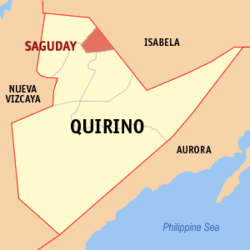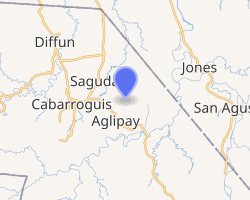Saguday
Saguday, officially the Municipality of Saguday (Ilocano: Ili ti Saguday; Tagalog: Bayan ng Saguday), is a 5th class municipality in the province of Quirino, Philippines. According to the 2015 census, it has a population of 16,070 people.[3]
Saguday | |
|---|---|
| Municipality of Saguday | |
 Seal | |
 Map of Quirino with Saguday highlighted | |
OpenStreetMap 
| |
.svg.png) Saguday Location within the Philippines | |
| Coordinates: 16°31′N 121°36′E | |
| Country | |
| Region | Cagayan Valley (Region II) |
| Province | Quirino |
| District | Lone District |
| Founded | June 21, 1959 |
| Barangays | 9 (see Barangays) |
| Government | |
| • Type | Sangguniang Bayan |
| • Mayor | Marcelina M. Pagbilao |
| • Vice Mayor | Ric B. Cadiente |
| • Congressman | Junie E. Cua |
| • Electorate | 10,307 voters (2019) |
| Area | |
| • Total | 55.50 km2 (21.43 sq mi) |
| Population (2015 census)[3] | |
| • Total | 16,070 |
| • Density | 290/km2 (750/sq mi) |
| • Households | 4,891 |
| Economy | |
| • Income class | 5th municipal income class |
| • Poverty incidence | 10.08% (2015)[4] |
| • Revenue (₱) | 55,569,122.65 (2016) |
| Time zone | UTC+8 (PST) |
| ZIP code | 3402 |
| PSGC | |
| IDD : area code | +63 (0)78 |
| Climate type | tropical rainforest climate |
| Native languages | Ilocano Ilongot Tagalog |
| Website | www |
History
Among the most memorable event in the chronicle of Saguday is June 21, 1959, the founding of this town as a regular municipality of then Province of Nueva Vizcaya by virtue of House Bill No. 2541, authored by Leonardo B. Perez, then Congressman of the Lone District of Nueva Vizcaya which pursuant to the provisions of Article VI, Section 20 (1) of the Philippine Constitution, became a law without the signature of President Carlos P. Garcia, entitled Republic Act No. 2519. Pursuant to Section 1 of this law, the seven barrios composing the Municipality of Saguday are as follows: La Paz, Saguday (now Rizal and Magsaysay), Salvacion, Santo Tomas which were separated from the Municipality of Diffun; while Dibul, Mangandingay and Tres Reyes were separated from the Municipality of Aglipay.
Originally, Saguday was a barrio of the Municipality of Santiago, Isabela, however, upon the final settlement of the boundary dispute between Isabela and Nueva Vizcaya, Saguday became a regular barrio of Diffun by virtue of an Executive Order No. 386, issued by then President Elpidio Quirino.
The naming of Saguday has no legendary story or folktale. It was named by Mr. Jose Cardenas of San Jose, Nueva Ecija, the grandfather of former Mayor Leandro G. Cardenas who came to visit his kins in Saguday. The word Saguday is an Ilocano term which connotes that one possesses good traits and blessed with clean mind, heart and soul.
The first settlers of Saguday were spearheaded by the adventurous and hardworking Ilocanos composed of the families of Corpuz, Cortez, Cabiles, Guzman and Bacani who hailed from the Province of Pangasinan, the Pagbilao and Olonan family from Ilocos Region, and the families of Cardenas, and Tomas from the Province of Nueva Ecija, who all came to exploit the vast virgin lands and forest of this very promising valley.
In August 16, 1959, the founding set of Local Officials to govern the Local Government Unit appointed by then President of the Republic of the Philippines Carlos P. Garcia have assumed office, with then Luis C. Lucas, Sr. as the Municipal Mayor, while the late Nicanor Pagbilao as the Municipal Vice Mayor.
Saguday was born as a sixth class municipality composing of seven (7) barrios, however, in the year 1980 and 1981, two (2) additional barangays were created. Barangay Cardenas was created in 1980 pursuant to Sangguniang Bayan Resolution No. 02, series of 1980, while Barangay Gamis was founded in 1981, pursuant to Resolution No. 05, Series of 1981. At present, Saguday is still a 5th Class Municipality due to its limited income which is attributed to scarce resources.
Upon the creation of the Municipality of Saguday, the urban core was divided into two barrios : District I now Barangay Magsaysay has been the seat of the Municipal Government from then up to present, and District II now Barangay Rizal.
Vision
Saguday will be a prime agro-industrial and residential investment destination in the province nurtured by God-loving, informed, empowered, and healthy citizens who live in a competitive and sustainable economy in a peaceful and pro-active community under a transparent, accountable and ethical governance.
Mission
To promote, uplift and transform the way of life of the people towards a competitive and sustainable economy through a good organizational climate, culture of change, and the delivery of accessible, comprehensive and quality services by means of a transparent, accountable and ethical governance.
Barangays
Saguday is politically subdivided into 9 barangays.
Demographics
| Year | Pop. | ±% p.a. |
|---|---|---|
| 1960 | 3,264 | — |
| 1970 | 4,866 | +4.07% |
| 1975 | 5,935 | +4.06% |
| 1980 | 6,673 | +2.37% |
| 1990 | 9,918 | +4.04% |
| 1995 | 10,900 | +1.78% |
| 2000 | 17,027 | +10.03% |
| 2007 | 13,479 | −3.17% |
| 2010 | 14,596 | +2.94% |
| 2015 | 16,070 | +1.85% |
| Source: Philippine Statistics Authority[3][5][6][7] | ||
References
- "Municipality". Quezon City, Philippines: Department of the Interior and Local Government. Retrieved 31 May 2013.
- "Province: Quirino". PSGC Interactive. Quezon City, Philippines: Philippine Statistics Authority. Retrieved 12 November 2016.
- Census of Population (2015). "Region II (Cagayan Valley)". Total Population by Province, City, Municipality and Barangay. PSA. Retrieved 20 June 2016.
- "PSA releases the 2015 Municipal and City Level Poverty Estimates". Quezon City, Philippines. Retrieved 12 October 2019.
- Census of Population and Housing (2010). "Region II (Cagayan Valley)". Total Population by Province, City, Municipality and Barangay. NSO. Retrieved 29 June 2016.
- Censuses of Population (1903–2007). "Region II (Cagayan Valley)". Table 1. Population Enumerated in Various Censuses by Province/Highly Urbanized City: 1903 to 2007. NSO.
- "Province of Quirino". Municipality Population Data. Local Water Utilities Administration Research Division. Retrieved 17 December 2016.